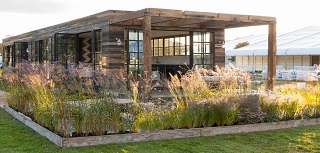From Guest Blogger Lana Hawkins: Build Your Own Eco-House Cheap

Proper Insulation Is the Key
There are plenty of ways to make your home more energy-efficient and some of these methods don’t require going into major remodelling projects and starting from scratch. If you’re looking for simple solutions, the best option is to focus your attention on properly insulating your home. Heating and cooling accounts for about 48% of energy use in a typical home, making it the largest expense in the household. The best way to reduce the amount of energy used from heating and cooling is to properly insulate your residence and rely on alternative ways of heating, i.e. solar power. A typical solar panel uses about 200 watts of power and depending on how much energy your house needs, you can opt for a different number of panels, different sizes as well as the efficiency of the cells inside.
Shine Some Light
Another easy trick that can help you make a more energy-efficient environment in your home as well as reduce the electricity bills is to consider your lighting solutions carefully. Instead of using traditional lighting bulbs, opt for a greener solution and replace your old bulbs with LED bulbs. Light Emitting Diodes as they’re originally called are known to consume 90% less energy than incandescent bulbs and can last up to 100,000 hours. Certainly, this isn’t the only way to green up your lifestyle. Not only is natural sunlight a clean source of energy, but it’s also scientifically proven that it holds many benefits for the human health. That’s why it’s a good idea to implement more natural light into your home, as well as install energy-efficient windows, preferably with an Energy Star label, to be sure that your windows provide protection from radiation, reduce condensation, as well as lower the HVAC costs.
Use Sustainable Materials
Using sustainable materials is one of the main principles of green building, so if you’re planning a big remodelling project or building a new home, the best solution is to rely on materials which won’t impact the environment in a negative manner. Wood is by far the eco-friendliest material and as such is excessively used in green architecture. The mixture of bamboo, cork and linoleum is commonly used for modern flooring, while you can always opt for wool bricks, sustainable concrete, straw bales, mycelium, ferrock and similar types of materials, which have gained global recognition as great substitutes to traditional building materials, as they significantly lower the environmental impact.
Size Does Matter
Lastly, the size of your house can greatly determine its efficiency. If you decide to build a smaller sized house, it’s going to require less building material, as well as less space that needs to be heated and cooled. Of course, this doesn’t necessarily mean that you have to reduce yourself to living in a prison cell, just to learn how to properly use all the space you have. For instance, you can seek inspiration from various project homes in Sydney, which show that even smaller houses made from waste and recycled materials can not only look spectacular, but also provide maximum efficiency to its residents.
There are many aspects that need to be considered when it comes to green architecture, and building your own eco house requires a fair bit of research, effort and dedication. The goal is to create a residence that’s going to be efficient in every sphere, starting from using sustainable materials and solar panels all the way to geothermal heating and wind turbines.

